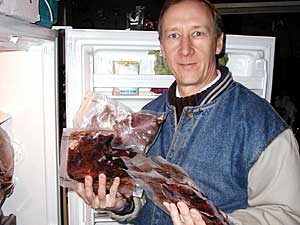|
Photos
More from MPR
Resources
Your Voice
|
Hunter ponders what to do with meat from CWD elk
January 20, 2004
 |
| Bemidji hunter Jim Treat shot an elk in Colorado last month that tested positive for chronic wasting disease. He has not yet decided whether to eat it. (MPR Photo/Tom Robertson) |
Bemidji, Minn. — Jim Treat of Bemidji admits he's a hunting fanatic. He lives for those few weeks each December when he heads to the Colorado mountains looking for prize elk. He's been doing it for 17 years. This season he shot the biggest one he's ever seen -- an estimated 800 pounds. It's now sitting in his freezer, cut up into steaks and burgers.
"I figure I have probably 200 to 220 pounds of meat here," said Treat, as he looks in his freezer. "I cut it up into packages just big enough for a family to eat. It's our favorite meal."
Treat shot the elk Dec. 18. As required by Colorado law, he left the head and spinal column behind to be tested for chronic wasting disease. Three weeks later, Colorado wildlife officials told Treat his elk tested positive. It was one of just 10 diseased elk found out of more than 8,000 shot by hunters this season.
 | |||
"Well, I tell you, it was a kick in the gut, because that's about the only meat we have," said Treat. "We love it. We eat it all winter."
Chronic wasting disease is a fatal brain disease that affects North American deer and elk. It was first detected in the U.S. in Colorado in the late 1970s. It's since been found in wild animals in a handful of other states, including Wisconsin and South Dakota. The disease has not been found in the wild in Minnesota, but there have been two cases of the disease found in captive elk.
Colorado has had an aggresive CWD program for a decade. Officials there say each year, dozens of infected animals are killed by out-of-state hunters. Todd Malmsbury of the Colorado Division of Wildlife says they contact hunters directly and recommend the meat be destroyed.
"While there's no information that we're aware of -- or that health officials have provided us with -- to show a link between this disease and human health," Malmsbury said, "simply to be prudent, we think it appropriate to tell people not to eat animals that have been determined to be diseased."
Colorado officials contacted Minnesota's DNR. That's standard policy for them. In this case, they did so via e-mail. A Minnesota biologist in St. Paul got the message Jan. 9. But as of a week later, DNR officials in northern Minnesota knew nothing about it. They first learned of Treat's infected elk when contacted for this story. DNR staff in St. Paul later admitted there had been miscommunication within the department.
|
It was a kick in the gut, because that's about the only meat we have. We love it. We eat it all winter.
- Jim Treat |
Jim Breyen, regional wildlife supervisor in Bemidji, says while Colorado recommends CWD infected animals not be eaten, Minnesota's policy is to make no recommendation at all.
"If he wants to eat the meat, that's fine," said Breyen. "If he chooses not to eat the meat and he wants to get rid of it, what we're advising him to do is dispose of it as he would other household garbage, making sure it ultimately ends up in a sanitary landfill."
Breyen was asked whether he would eat the meat if it were his.
"I've never had to come to that decision, so, I probably would not eat it," he said.
Breyen says, as far as the DNR knows, Jim Treat's elk is the third CWD-infected animal to be brought into Minnesota by hunters. A law passed last year makes it illegal to bring heads or spinal columns from deer or elk killed in other states.
Jim Treat's elk is still sitting in his freezer, but probably not for long. Treat says he'd probably eat it, if it weren't for his wife's objections. He says the whole experience has been frustrating, but it won't stop him from hunting elk.
"I'm going back every year," said Treat. "I love it too much. I'm going to take this as the unluck of the draw, I guess."
The Minnesota DNR has so far found no sign of chronic wasting disease in the state's wild deer. They're hoping that holds true for the nearly 9,000 samples still waiting to be tested from last fall's hunting season.
Meanwhile, officials in Wisconsin continue their battle with the disease. It was discovered in wild deer in southwestern Wisconsin nearly two years ago. Experts now fear the disease could spread northward.
|
News Headlines
|
Related Subjects
|
